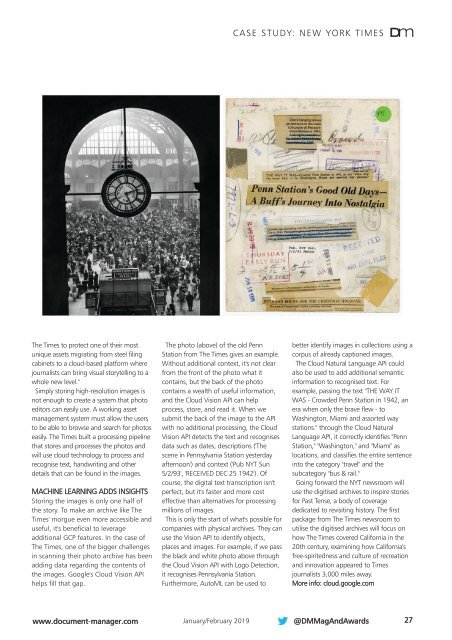DM1901
Create successful ePaper yourself
Turn your PDF publications into a flip-book with our unique Google optimized e-Paper software.
CASE STUDY: NEW YORK TIMES Dm<br />
The Times to protect one of their most<br />
unique assets migrating from steel filing<br />
cabinets to a cloud-based platform where<br />
journalists can bring visual storytelling to a<br />
whole new level."<br />
Simply storing high-resolution images is<br />
not enough to create a system that photo<br />
editors can easily use. A working asset<br />
management system must allow the users<br />
to be able to browse and search for photos<br />
easily. The Times built a processing pipeline<br />
that stores and processes the photos and<br />
will use cloud technology to process and<br />
recognise text, handwriting and other<br />
details that can be found in the images.<br />
MACHINE LEARNING ADDS INSIGHTS<br />
Storing the images is only one half of<br />
the story. To make an archive like The<br />
Times' morgue even more accessible and<br />
useful, it's beneficial to leverage<br />
additional GCP features. In the case of<br />
The Times, one of the bigger challenges<br />
in scanning their photo archive has been<br />
adding data regarding the contents of<br />
the images. Google's Cloud Vision API<br />
helps fill that gap.<br />
The photo (above) of the old Penn<br />
Station from The Times gives an example.<br />
Without additional context, it's not clear<br />
from the front of the photo what it<br />
contains, but the back of the photo<br />
contains a wealth of useful information,<br />
and the Cloud Vision API can help<br />
process, store, and read it. When we<br />
submit the back of the image to the API<br />
with no additional processing, the Cloud<br />
Vision API detects the text and recognises<br />
data such as dates, descriptions ('The<br />
scene in Pennsylvania Station yesterday<br />
afternoon') and context ('Pub NYT Sun<br />
5/2/93', 'RECEIVED DEC 25 1942'). Of<br />
course, the digital text transcription isn't<br />
perfect, but it's faster and more cost<br />
effective than alternatives for processing<br />
millions of images.<br />
This is only the start of what's possible for<br />
companies with physical archives. They can<br />
use the Vision API to identify objects,<br />
places and images. For example, if we pass<br />
the black and white photo above through<br />
the Cloud Vision API with Logo Detection,<br />
it recognises Pennsylvania Station.<br />
Furthermore, AutoML can be used to<br />
better identify images in collections using a<br />
corpus of already captioned images.<br />
The Cloud Natural Language API could<br />
also be used to add additional semantic<br />
information to recognised text. For<br />
example, passing the text "THE WAY IT<br />
WAS - Crowded Penn Station in 1942, an<br />
era when only the brave flew - to<br />
Washington, Miami and assorted way<br />
stations." through the Cloud Natural<br />
Language API, it correctly identifies "Penn<br />
Station," "Washington," and "Miami" as<br />
locations, and classifies the entire sentence<br />
into the category "travel" and the<br />
subcategory "bus & rail."<br />
Going forward the NYT newsroom will<br />
use the digitised archives to inspire stories<br />
for Past Tense, a body of coverage<br />
dedicated to revisiting history. The first<br />
package from The Times newsroom to<br />
utilise the digitised archives will focus on<br />
how The Times covered California in the<br />
20th century, examining how California's<br />
free-spiritedness and culture of recreation<br />
and innovation appeared to Times<br />
journalists 3,000 miles away.<br />
More info: cloud.google.com<br />
www.document-manager.com<br />
January/February 2019<br />
@DMMagAndAwards<br />
27

















